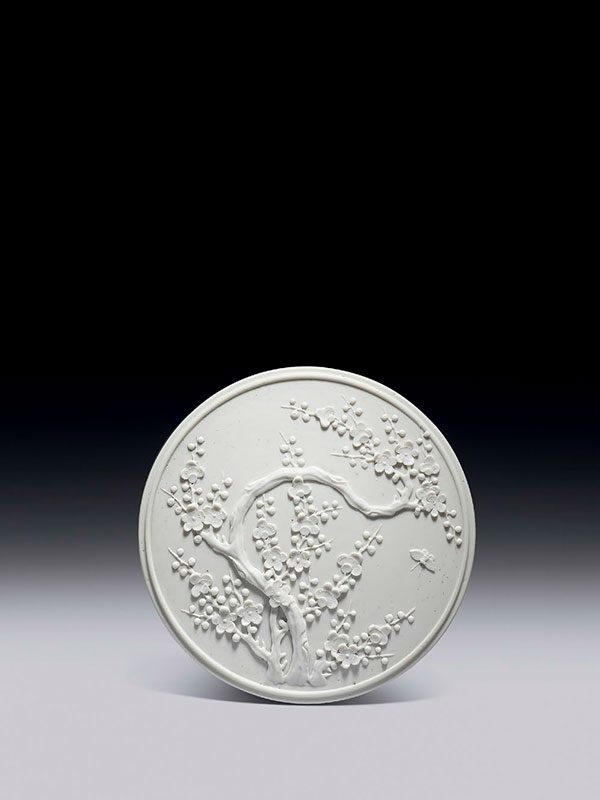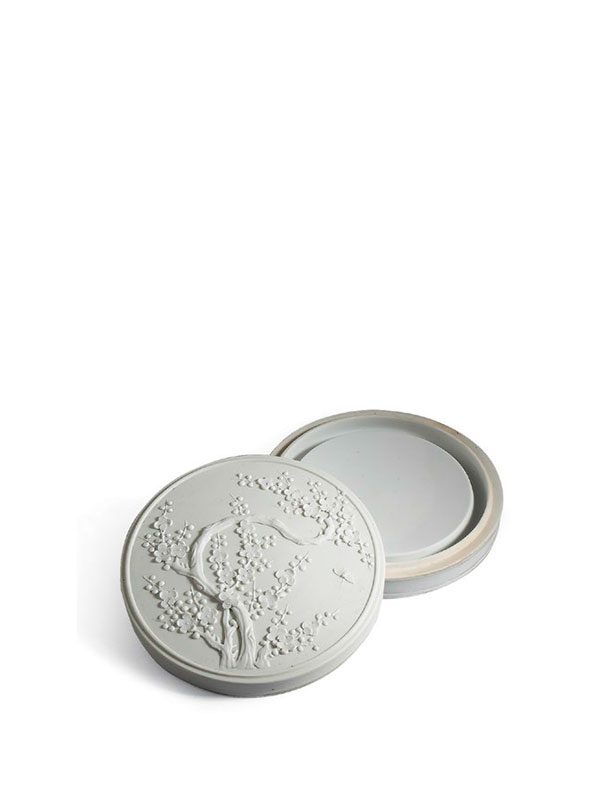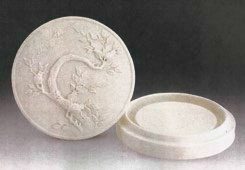Carved biscuit porcelain ink stone and cover
An unglazed biscuit porcelain ink grinding stone of circular form, contained within a circular box. The flat cover is carved in high relief with a butterfly flying among branches of plum blossoms and buds. The scene is encircled by a raised band. The concave ink-grinding slab is raised from the box and set in a deep water-pool in the form of a gutter. The rims of the cover, box and the straight sides are beaded. The box is of an even creamy white colour.
This elegantly made ink slab contained in a box is a fine example of a scholar’s piece popular in the late 19th century. The biscuit (twice fired) porcelain body, a type of unglazed porcelain with a matte appearance and texture, unusually retains the simplicity of its original purpose. An ink stone or slab is one of the essential writing tools on the scholar’s desk. In order to make ink, an ink stick is ground on the slab surface whilst water is gradually added. Circular ceramics ink slabs have a long history in China, and it was in the late Southern Dynasties period (5th – 6th century) that the surface of the ink slab was raised, resulting in a drainage channel all around. This type is known as a piyong ink slab and might have been the prototype of the current example.[1] The carving of porcelain (diaoci in Chinese) was inspired by carvers of other materials (i.e. ivory, bamboo and lacquer) and came into fashion in China towards the end of the 18th century. The decoration is carved when the porcelain has dried to a certain hardness but before it was fired in the kiln, creating a threedimensional effect with a depth that is not available in painted porcelain. Butterflies often symbolise beauty, romance and dreams; the depiction of flowers and butterflies together is a sign of a ‘permanent feeling of affinity’ or conjugal fidelity.[2] A closely comparable biscuit porcelain ink slab in the collection of Humphrey K. F. Hui in Hong Kong, carved with pomegranate branches, similar in form and size, is dated to the Daoguang to Guangxu period (fig. 1).[3] Another example of similar form and size, carved with a landscape on the cover and dated to the Guangxu period (1875 – 1908), is one of a desk set that comprises ten pieces and is in the collection of Tony Miller.[4]
- For an example of a piyong ink slab, covered in white glaze and dated to the Tang dynasty, see: Wong, A. (ed) Enlightening Pursuits, Scholar’s Objects from the Mengdiexuan Collection, University of Hong Kong, University Museum and Art Gallery, Hong Kong, 2006, no. 1
- Welch, P. B. Chinese Art- A Guide to Motifs and Visual Imagery, Tuttle Publishing, Singapore, 2012, p. 91
- Miller, T. and Hui H. Carved Porcelain from Jingdezhen of the 19th to early 20th century, Art Museum, The Chinese University of Hong Kong, 2006, no. 117, p. 266
- Miller, T. and Hui H. op. cit. no. 145, p. 300
雕瓷梅花粉蝶圓形蓋硯
清末 道光至光緒 1821 – 1908
徑:12 公分 高:3.2公分
蔗段式素瓷盒,子母口,直壁,平頂蓋面淺浮雕梅樹數枝,枝頭梅花綻放,含苞並蒂,一粉蝶翩
翩飛舞於其間,閒趣雅逸。盒內有隆起圓形硯,硯面微凹,周圍環以凹型水槽。硯是文房四寶之
一,供磨墨用,多以石材製成。此硯形制與晉唐盛行之辟雍硯相呼應,應以其為本。雕瓷是以陶
瓷素胚造型為基礎,以雕刻、模印等技術來表現裝飾題材的一種傳統製瓷工藝。雕瓷技術從唐宋
時期開始,十九世紀末素胎雕瓷文具製作再度流行。香港中文大學文物館曾於2006年舉辦「素影
浮瑩 – 景德鎮清末民初雕瓷」展,展品中有三件雕瓷圓形蓋硯,形制、大小與雕刻均與本品相
似,定年亦為道光至光緒年間製品。



